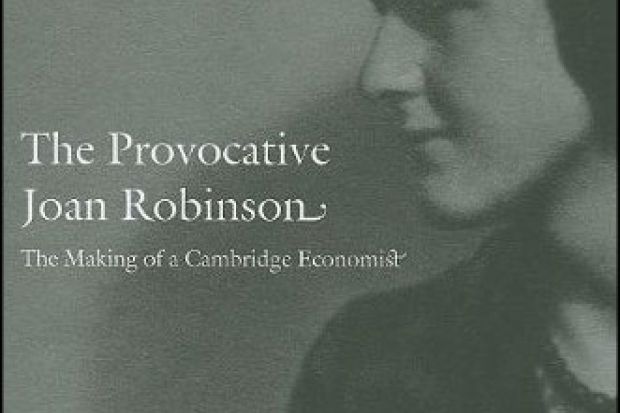When Joan Robinson arrived at the University of Cambridge in 1929, she was a faculty wife with an undistinguished academic record and no scholarly ambitions of her own. By 1938, when she was appointed to a university lectureship, she had an international research reputation and was regarded by John Maynard Keynes as among the top half-dozen in the economics faculty. Nahid Aslanbeigui and Guy Oakes examine how she made this remarkable transformation.
Robinson wanted to be financially independent. She held economics supervisions from her flat because it was the only acceptable work she could find. She attended lectures, where she heard Piero Sraffa's attack on the assumption of perfect competition. When firms are small relative to the market, individual firms cannot affect the price. They maximise profit by producing until the cost of the last unit equals its price. But this analysis fails when firms are large: production of an extra unit causes a decrease in the price for all units, so the marginal revenue of the last unit is less than its price.
The authors draw on unpublished correspondence to show that Robinson's husband, Austin, introduced her to an important new analytic tool, the marginal revenue curve. In 1930, she, Austin and Richard Kahn planned to collaborate on a book showing how marginal revenue could explain various empirical phenomena. Since Austin and Kahn were faculty, with associated duties and other research projects, Robinson took the lead. By 1932, they all considered the authorship of the book to be Robinson's alone. She and Austin agreed to postpone having children until she had "reorganised economics". Robinson worked quickly and The Economics of Imperfect Competition was published in 1933 to immediate critical acclaim.
In producing the book, Robinson drew on other researchers with similar interests. Kahn, who Aslanbeigui and Oakes originally and persuasively argue was Robinson's lover as well as collaborator and friend, had a large input. She averted an incident with another Cambridge economist, Gerald Shove, who thought she had used material from his unpublished lectures. A potentially damaging exchange with Arthur Cecil Pigou turned out to be an advantage. Pigou detected a mathematical defect in the argument. Robinson could not understand his point and would not explain why - she did not know any maths. Fortunately, Pigou solved the problem for her, was modest about its import, and generous about where the credit lay.
The book established Robinson's scholarly credentials, but she lacked a patron. She set her sights on Keynes, of whom she was an early enthusiast. He first saw her as a nonentity, then as a nuisance (for endangering the reputation of Kahn). But, unlike the faculty, Robinson had no prior theoretical commitments to prevent her from championing Keynes wholeheartedly. In 1935, when he needed sympathetic criticism of the manuscript of The General Theory, she was the natural choice. Her advance knowledge enabled publication of her essays on the theory's implications for employment only a year behind it, and Keynes reciprocally commented on her work.
For Robinson, simplicity was key. She advised Keynes to "write as tho' for a second year man who is hoping to get a II2". By writing books that could be read by students, she accessed the next generation of economists. Robinson's commitment to simplicity was also methodological. In Economics is a Serious Subject (1932), she argued that economists should use tractable assumptions, at the expense of treating simplified problems rather than tackling the real world.
The faculty board recommended Robinson for university lectureship without the customary plaudits, which Keynes regarded as a slight. Some of the negative feeling towards her, such as the perception that she was rude and pushy, may have been exacerbated because she was a woman. Robinson regarded economics as an androgynous enterprise, but her success was remarkable given her gender. In 1930s Cambridge there was academic and social separation of the sexes. Women were not guaranteed entry to lectures and they were excluded from meals, holidays and other social forums where education and research were informally conducted. The authors suggest that, ironically, being female did give Robinson one advantage: as a childless housewife with a maid she had plenty of time for research, while her husband and his colleagues had administrative duties.
The authors give the impression that Robinson was more strategist than economist and that, at best, her early work was derivative, involving the extension of other people's ideas. One weakness of the book is that the economics is underexplained, so a reader without prior knowledge will have trouble following the theoretical debates. But the historical reconstruction is intertwined with a fascinating anthropology of the Cambridge economics faculty in the 1930s. Aslanbeigui and Oakes convincingly argue that there was an epistemic community, albeit one whose members battled fiercely for acknowledgement, where bit-players such as Robinson had an important role in contributing to the formation of big ideas.
The Provocative Joan Robinson: The Making of a Cambridge Economist
By Nahid Aslanbeigui and Guy Oakes
Duke University Press
320pp
£62.00 and £15.99
ISBN 9780822345213 and 45381
Published 8 October 2009
Register to continue
Why register?
- Registration is free and only takes a moment
- Once registered, you can read 3 articles a month
- Sign up for our newsletter
Subscribe
Or subscribe for unlimited access to:
- Unlimited access to news, views, insights & reviews
- Digital editions
- Digital access to THE’s university and college rankings analysis
Already registered or a current subscriber? Login
